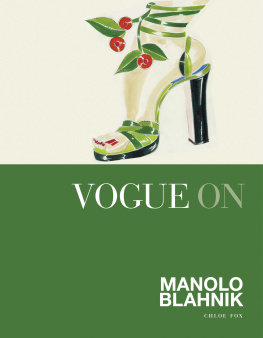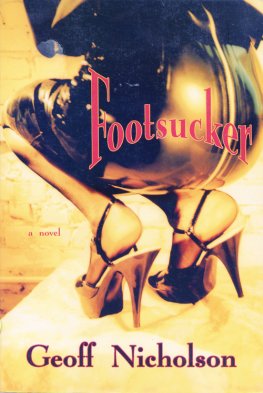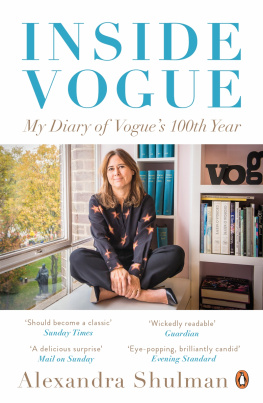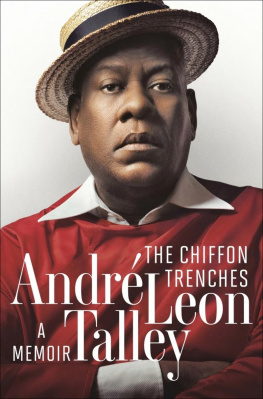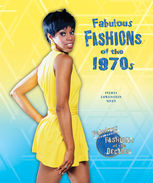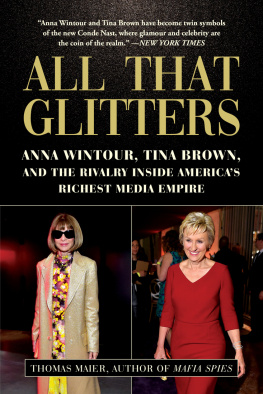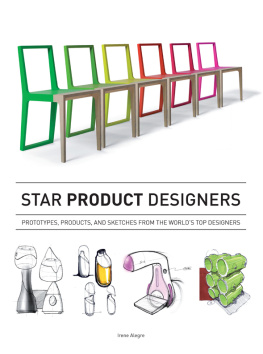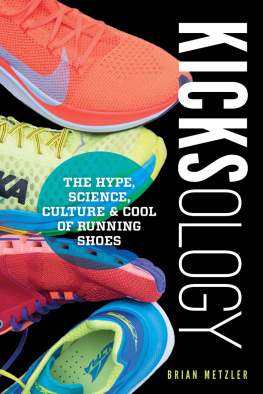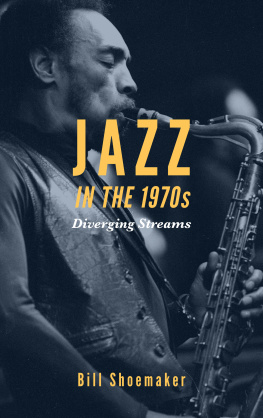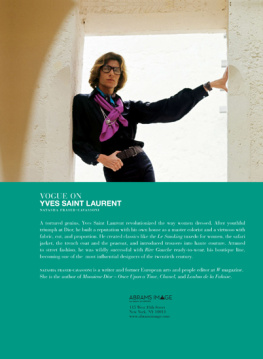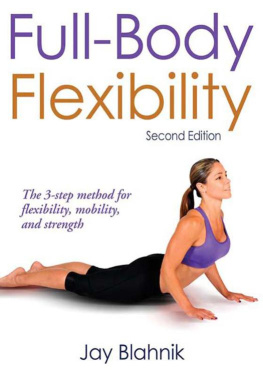CONTENTS
The Master at work: Blahniks creative process always begins with a drawing. Photograph by Ivan Terestchenko.
An illustration of a Liberty print shoe, designed and drawn by Blahnik for his pop-up shop at the celebrated department store in September 2010.
A September 2009 Mark Mattock photograph places a pair of Blahniks sculpted petrol-blue satin stilettos at the centre of a glamorous nighttime still life.


I n January 1974, Manolo Blahnik appeared on the cover of Vogue; he is only the second man ever to appear thus in the magazines 60-year history. There is much that is remarkable about this photograph of a tall, elegant couple standing, champagne glasses in hand, in a posed moment of intimacy against a Mediterranean sunset. It was taken by a 36-year-old David Bailey and styled by a 32-year-old Grace Coddington, both of them at the beginning of two groundbreaking careers in fashion. And their cover stars are not models, but real people, faces-about-town, with stories beyond their beauty. One is Anjelica Huston, the 22-year-old American daughter of legendary film director John Huston and a future Oscar-winning actress. The other is the 31-year-old half-Spanish, half-Czechoslovakian shoe designer du moment, who is fast becoming a star of the London fashion scene. Matinee-idol handsome, refined and dressed in his own clothes, the shoe designer appears on every page of the fourteen-page French Leave fashion story inside, shot in Corsica and the South of France. At times, he and Huston are joined by other non-models; for example the photographer Helmut Newton and Coddington (herself a former model) are both in on the impossibly glamorous party. The story which moves effortlessly from beach front to bedroom is the perfect showcase for the talents of all of its key cast and crew; Baileys energetic realism, Coddingtons eye for the sublime, Hustons dramatic presence and Blahniks beautiful shoes, showcased in all their glory on every page.
In 1974, Grace Coddington cast Manolo Blahnik as a model for the French Leave story she was shooting with David Bailey and the actress Anjelica Huston (pictured) on location for Vogue. Even now, I think of this as one of the happiest trips of my life, says the designer.
Interviewed over forty years later, the designer was delighted to be shown these photographs. Oh Anjelica. So beautiful! he exclaimed. Whenever we see each other, even now you know, we say Vive La Corse! We had so much fun, you see. At 74, the effervescent Manolo Blahnik is, for all his immaculate old school charm, a wonderfully ageless man, as his friend and champion Anna Wintour describes him. I remember everything, he says. Everybody. To me, the beginning is like yesterday.
WE HAD SO MUCH FUN, YOU SEE.
MANOLO BLAHNIK
In another David Bailey shot from French Leave, Blahnik sits between the photographer Helmut Newton, who was also along for the ride, and Huston, whom Blahnik describes as a beautiful girl, inside and out, and who wears a pair of elegant black patent sandals of his design.
Blahniks Leaf Sandal, drawn in 1974, the same year in which he appeared in Vogue, illustrates the designers lifelong passion for botanical motifs, borne of a childhood spent on the subtropical Canary Island of La Palma.



T he beginning of Blahniks career had come three years before that Corsican summer. He had arrived in Britain from Paris, where he had been studying art, with an aim to develop his skills as a theatre designer. It was a Golden Age for London, and for me too, he recalled. There was such an energy, such an atmosphere and I was right there, breathing it all in. Wherever else I had lived, I had always felt foreign. But when I came here, I felt different. I felt like London was the place for me. In 1971, fashionable London was in the middle of a creative surge that had started in the Swinging Sixties. Beautiful, liberated young creatures displayed street fashion on the pavements of Carnaby Street and the Kings Road; designers such as Jean Muir, Bill Gibb and the great Ossie Clark set new styles, while some of the best magazine editors that Britain has ever seen documented this new scene. Under Will Landels, Harpers & Queen showcased the Chelsea set, while Beatrix Millers Vogue deftly blended the quixotic with the quintessentially English and placed London firmly at the heart of a global cultural shift.
There is something of the grandee about him wrote Joan Juliet Buck in a December 1979 interview for British Vogue, photographed by Eric Boman. His apartment in Notting Hill is the apartment of a gentleman, with baronial cupboards full of biographies, statues of Satyrs, carved beds and chandeliers illuminated with real candles.
In order to stay permanently Blahnik needed a work permit, and, in order to get a work permit, he needed a job. Jean Burstein, the then proprietor of Feathers boutique in Kensington (not to be confused with Joan Burstein, the doyenne of the famous Browns boutique on South Molton Street), came to the aid of the bright young thing who, by virtue of his varied European upbringing, spoke fluent Spanish, English, French, German and Italian. The job she gave him was not particularly to his taste looking after the press for the New Man jeans label but it was all he needed to stay in London. To this day, Blahnik credits Mrs Burstein with teaching him all he needed to know about the business of fashion retailing. She had the most brilliantly sharp eye, he recalled. And a rigorous work ethic.
Feathers was one of the most fashionable boutiques in London and its new, flamboyantly handsome employee quickly caught the attention of the top fashion journalists of the time. When Vogues Catherine Millinaire asked him to help her to find subjects for a possible feature on people in London who dressed in an extraordinary way, they quickly struck up a friendship. Catherine introduced him to her brother, the actor Gilles Millinaire, who became Blahniks flatmate in his small, immaculately minimalist flat on Warwick Street.

